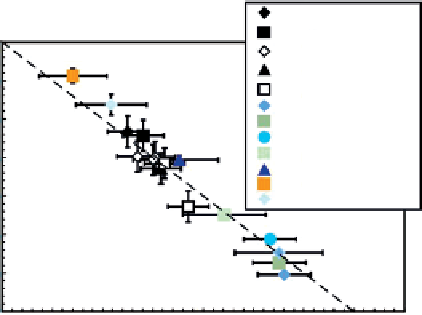Geology Reference
In-Depth Information
CM2 chondrite
67.297 g
Found December 15, 1997
5.5 × 3.5 × 3.0 cm
Weathering = Be
been at the center of many studies focused on aqueous alteration on their
parent bodies, and on the abundance and species of organic matter. They
are distinguished by their small (~300 micron) chondrules, accretionary
rims around chondrules, common calcium-aluminum-rich inclusions (CAi),
and amoeboid olivine aggregates (AoA), with little to no FeNi metal and a
high matrix (~70%) that contains phyllosilicates, carbonate, sulfides, and
magnetite. Alteration postdates primary features such as chondrules and
CAis, producing some impressive textures in CM2 chondrites.
Murchison
Murray
Mighei
Nogoya
Cold bokkeveld
MET 01070
SCO 06043
ALH 83100
QUE 93005
ALHA 81002
QUE 97990
Y 791198
35%
QUE 97990,0
30%
25%
20%
15%
10%
5%
0%
80 %
To tal phyllosilicate (Mg-serpentine +Fe-cronstedtite) vol%
60 %65% 70 %75%
85 %90% 95 %100 %
(a)
(b)
Plate 11
MiNERALogy
SigNiFiCANCE
This meteorite consists of a few small chondrules (up to
1 mm), mineral grains and CAis set in a black matrix.
The matrix contains coarse serpentine-tochilinite inter-
growths, 1-2 vol% of 10-30 mm-size carbonate grains,
1.4 vol% pyrrhotite and pentlandite, and ~1 vol% metallic
Fe-Ni within porphyritic chondrules and as relatively
coarse grains in the matrix. olivine compositions are
Fa
0-61
, with many Fa
0-2
; orthopyroxene is Fs
0-1
.
Among the CM chondrites, QUE 97990 exhibits evidence
for the least amount of aqueous alteration (top left, [38]),
has a suggested petrologic type of 2.6 [39], and is thus an
end member for understanding the full range of textures
and mineralogies that are representative of aqueous alter-
ation on asteroid parent bodies. The degree of alteration
is minor compared to the rather altered Cold Bokkeveld
(bottom, [40]).
References [37-41]




